Ray Archuleta, the Conservation Agronomist for the USDA’s National Soil Health and Sustainability Team [1] says when he sees a tilled field, he sees a field that is naked, thirsty, and running a fever. Tillage leaves the soil bare to erosion, dries it out, and burns the organic matter in the soil.
Why do tillage then? Well, it does work. Burning that organic matter releases nutrients for the crop you are growing. Eventually though you run out of organic matter. Estimates are that we’ve gone through about half of the organic matter in the soil in the last 150 years. If we don’t change our farming practices in just a few generations we’ll have depleted the fertility of our soils[2].
In nature soil is never tilled and is never bare. There’s always something growing. That’s what we’re trying to do with our farming practices.
Last week we seeded rye grass, cereal rye, and crimson clover with an airplane into our standing corn and soybeans. The rye and clover should get started and continue to grow until next spring when we’ll kill it to plant next year’s corn and soybeans.
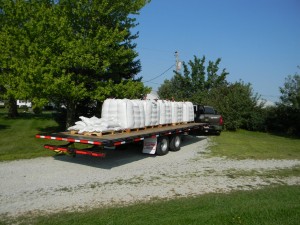
This is half our cereal rye seed in the big bags. The bags weigh 2200 pounds each.
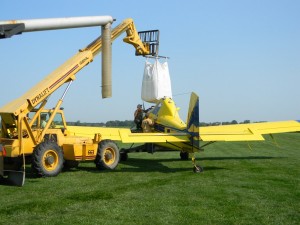
Using a big ol’ loader (a telehandler) they dump the bags directly into the airplane.
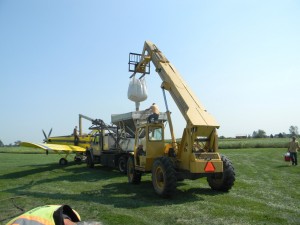
Or they would dump several bags into a tender truck and use the truck to load the plane. If you want to put one and a half bags in a plane, this is how you have to do it. Once you open one of those big bags you pretty much have to take it all, you can’t stop half way.
In our wheat fields that were harvested in July we planted daikon radishes and Austrian winter peas. We planted those a month ago and they’re growing like crazy now.
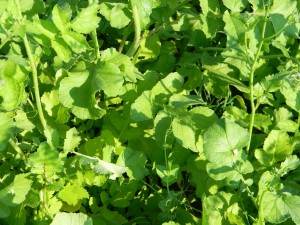
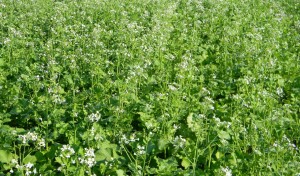
All these plants growing in our fields will take up nutrients, the fertilizers we’ve applied. Without something growing some of those nutrients will be lost. They can end up in the rivers and eventually cause the dead zones in the Gulf of Mexico and Lake Erie. But when the growing plants take up the nutrients they’re not lost to us. When the plants die the nutrients are available to our crops in the decaying organic matter.
The roots of the growing plants help prevent erosion to keep our soil in our fields, not washing down the rivers or blowing through the air. And the roots help the texture of the soil, keeping it permeable to rainfall.
We have cover crops on every acre of our farm this year. While cover crops present challenges, I’m excited about the benefits and potential they bring.
[1] If you’re one of those who like to bash the government and think that government bureaucracies are wasteful and useless, the work of national conservationists like Ray Archuleta and our own local Whitley County District Conservationist Amy Lybarger are counter-examples. They work hard to help farmers protect the soil. I can’t think of any better use of our tax dollars than to protect our food source. People like Ray and Amy are making that happen. I’m pleased to work with them and to send my tax dollars to support their work.
[2] Looking for a more authoritative voice on this subject than mine? Check out the book Bread, Beer and the Seeds of Change by Thomas R. Sinclair. Particularly the chapter on Italy, the depletion of their soils, and the fall of the Roman Empire.
Leave a Reply